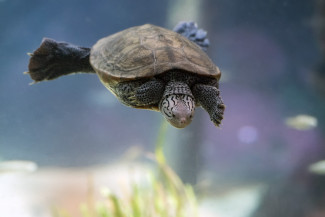
Johns Hopkins UniversityEst. 1876
America’s First Research University
Ecology and Conservation of the Diamond-backed Terrapin

The Diamond-backed Terrapin has a long and illustrious history, first as a culinary plight to satiate the masses and then becoming an epicurean fad for the well-heeled. The fad faded in the early 20th century because populations declined and the demand for terrapin flesh could no longer be met. Populations are thought to have recovered somewhat thereafter, but in the meantime, crab pots were invented and began drowning terrapins, their habitat declined due to development and urban sprawl, and a demand for turtle flesh and pets in the Far East resurrected their harvest. This combination again threatens terrapins throughout their geographic range and the precipitous decline in many populations has alarmed researchers, conservationists, and resource managers. The need for an amalgamation of the past and present of terrapin biology, history, and management dilemmas motivated our book.
Terrapins have a coastal geographic range from Massachusetts to Texas and are the only true estuarine turtle. The variation in environmental conditions experienced throughout their range (semi-tropical to fully temperate) have resulted in broad geographic differences in activity season, life history phenotypes, and coloration; interestingly terrapins remain genetically very similar throughout their extensive range. The estuarine habitat also creates interesting physiological challenges unique to terrapins in how they acquire freshwater and expel salt. On the other hand, the terrapin life cycle and life history is quintessentially “turtle”; long lives, delayed reproduction, and low juvenile survival that make the turtle phenotype highly sensitive to increases in adult and sub-adult mortality. Therefore, terrapins are appealing to study and understand because there are aspects of their biology that are truly unique and other traits that make them an excellent model system to understand basic turtle biology and conservation. Perhaps only two other species of turtle, the slider (Trachemys scripta), and the snapping turtle (Chelydra serpentina) are better studied than the terrapin; both are excellent model systems but not as inherently vulnerable and quite different from terrapins.

Our book, Ecology and Conservation of the Diamond-backed Terrapin, brings together the current state of knowledge of the Diamond-backed Terrapin and we hope that it will inspire new research directions as well as improved management and policy for terrapin conservation. Although our book primarily targets academic and management audiences, we also provide a basic understanding of the terrapin’s biology and plight that is appealing to a readership with more general interests in terrapins and turtles. Students of terrapin biology can learn features of their genetics, life histories, and physiology while conservationists and resource managers can learn of the threats terrapins face. Pollution, habitat loss, crab pots and other commercial gear, and a high demand that could inspire poaching threaten terrapins and these effects are summarized in our book. We also present an optimistic outlook for terrapins because there are populations that, when provided the appropriate conditions in areas without nest predators, exemplify how populations can be robust and increasing. Expanding terrapin populations provide the opportunity to test and explore new methods for turtle conservation with the hope of maintaining these immensely popular and charismatic animals for future generations.
Willem M. Roosenburg is the director of the Ohio Center for Ecology and Evolutionary Studies and a professor of biological sciences at Ohio University. Victor S. Kennedy is emeritus professor at the University of Maryland Center for Environmental Science. He is the author of Shifting Baselines in the Chesapeake Bay: An Environmental History. Together, they are the editors of Ecology and Conservation of the Diamond-backed Terrapin.

